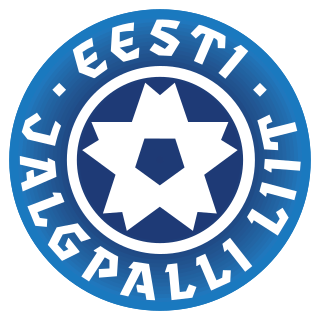
The San Marino national football team represents San Marino in men's international association football competitions. The team is controlled by the San Marino Football Federation and represents the smallest population of any UEFA member. They are currently the lowest-ranked FIFA-affiliated national football team.

The Lithuania national football team represents Lithuania in men's international football, and is controlled by the Lithuanian Football Federation, the governing body for football in Lithuania. They played their first match in 1923. In 1940, Lithuania was occupied by the Soviet Union; the country regained its independence in 1990 and played their first match thereafter against Georgia on 27 May of that year.

The Latvia national football team represents Latvia in men's international football, and is controlled by the Latvian Football Federation, the governing body for football in Latvia. They have never qualified for the FIFA World Cup, but did qualify for the European Championship in 2004 under head coach Aleksandrs Starkovs.

The Estonia men's national football team represents Estonia in international football matches and is controlled by the Estonian Football Association, the governing body for football in Estonia. Estonia's home ground is Lilleküla Stadium in the capital city Tallinn.

The Honduras national football team represents Honduras in men's international football. The team is governed by the Federación Nacional Autónoma de Fútbol de Honduras. They are nicknamed Los Catrachos, La Bicolor, or La H.

The Tunisia national football team represents Tunisia in men's international association football. The team is a member of both FIFA and CAF, the Confederation of African Football. It is governed by the Tunisian Football Federation, founded in 1957. Colloquially known as the Eagles of Carthage, the team's colours are red and white, and the bald eagle is its symbol. Most of Tunisia's home matches are played at the Hammadi Agrebi Stadium in Radès since 2001.

The 1993 season was the second complete year of competitive football (soccer) in Estonia since gaining independence from the Soviet Union in 1991-08-20. The Men's National Team booked its first victory since independence by defeating Lithuania at the Baltic Cup, on 1993-07-04.
The 1991 Baltic Cup football competition took place from 15 to 17 November 1991 at the Žalgiris Stadium in Klaipėda, Lithuania. It was the first competition of the three Baltic states – Latvia, Lithuania and Estonia – since they regained their independence from the Soviet Union, earlier that year. The FIFA did not recognize the games as full internationals.
The 1992 Baltic Cup football competition was 12th season of the Baltic Cup and took place from 10–12 July 1992 at the Daugava Stadium in Liepāja, Latvia. It was the second annual competition of the three Baltic states – Latvia, Lithuania and Estonia – since they regained their independence from the Soviet Union in 1991. This time, FIFA did recognize the games as full internationals.
The 1993 Baltic Cup football competition took place from 2–4 July 1993 at the Kalevi Stadium in Pärnu, Estonia. It was the third annual competition of the three Baltic states; Latvia, Lithuania and Estonia; since they regained their independence from the Soviet Union in 1991.

The 1994 season was the third full year of competitive football (soccer) in Estonia since gaining independence from the Soviet Union on 20 August 1991.

The 1995 season was the fourth full year of competitive football (soccer) in Estonia since gaining independence from the Soviet Union on 20 August 1991.

The 1996 season was the fifth full year of competitive football (soccer) in Estonia since gaining independence from the Soviet Union on 20 August 1991.

The 1997 season was the sixth full year of competitive football (soccer) in Estonia since gaining independence from the Soviet Union on 20 August 1991.

The 1998 season was the seventh full year of competitive football (soccer) in Estonia since gaining independence from the Soviet Union on 20 August 1991.

The 1992 season was the second season of competitive football (soccer) in Lithuania as an independent nation since regaining independence from the Soviet Union in 1990.
The 1992 season was the 72nd season of competitive football (soccer) in Estonia, and the first one in the Baltic country as an independent nation. The Estonia national football team under the guidance of manager Uno Piir played its first FIFA-recognized match after the restoration of independence against Slovenia on June 3, 1992: a 1-1 draw in the capital Tallinn. The team played a total number of five official matches in the year 1992, including two qualifiers for the 1994 FIFA World Cup in the United States.
The 1993 season was the second full year of competitive football in the Baltic country as an independent nation. After one loss and one draw in 1992 the Estonia national football team, led by manager Uno Piir, carried on in the 1994 FIFA World Cup qualification. Estonia played a total number of fourteen official matches in 1993. The only win came on July 4 against Lithuania in the Baltic Cup 1993, which was played in the Pärnu Kalevi Stadium.
The 1996 season was the fifth full year of competitive football in the Baltic country as an independent nation. After having a poor run in 1995 the Estonia national football team started in the qualifying tournament for the 1998 FIFA World Cup in France. The team had a new coach: Teitur Thordarson from Iceland.
The international friendly between the Albania and Kosovo national football teams on 14 February 1993 was the first match played by Kosovo after the partition of Football Federation of Kosovo from Football Association of Yugoslavia. It took place at the Selman Stërmasi Stadium in Tirana, Albania with 14,000 fans in attendance.
This page is based on this
Wikipedia article Text is available under the
CC BY-SA 4.0 license; additional terms may apply.
Images, videos and audio are available under their respective licenses.









